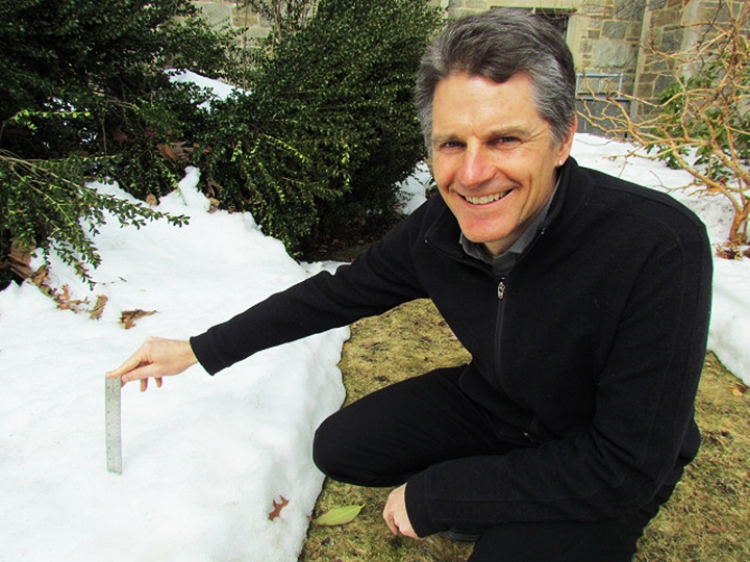
By
With the arrival of equinoctial spring, the historic winter of 2015 at last seems truly over. But the postscript is still not quite finished.
Call it the Great Snowmelt of 2015.
Sooner or later, the approximately 108 inches of snow Boston received this winter – most of it from late January through February – will fall victim to the effects of sun, warmth and rain. This month, with moderating temperatures and periods of rain, has already seen a considerable decrease in the snowpack.
While many will likely mark its passing with hardly a thought (other than relief), for some the snow’s inevitable disappearance raises questions about possible environmental impacts, good and bad, short and long-term.
To appreciate the dimensions of the snowmelt now in progress, Associate Professor of Earth and Environmental Sciences Noah Snyder says it’s useful to take a look at the snow water equivalent (SWE) figures as compiled by the Northeast River Forecast Center. As of mid-March, he says, Boston had a SWE of about two to four inches; the maximum SWE following the procession of severe winter storms was eight to 10 inches of water. Looking at precipitation data for January and February, Boston received about seven inches of water equivalent.
“That’s actually pretty normal for two months,” he says, “It’s just that usually it doesn’t all fall as cold, fluffy snow.”
Impatient as many Boston-area residents might be to see the snow disappear, Snyder says the “gentle” melting pattern of late – where the weather has been sunny with temperatures in the 30s and low 40s – has lessened the danger of flooding and should benefit yards and other greenery.
“The melt is recharging the groundwater, which is good for plants and trees,” he says. “Because the water is accumulating at a steady pace rather than all at once, it creates a reservoir for the soil, and lawns that drain reasonably well should do just fine.”
But if April’s legendary showers become a deluge, areas vulnerable to flooding, like the University’s Lower Campus, may face additional risk if there is sufficient snowpack left. Snyder points out, however, that typically floods on Lower Campus have been caused most often by rainfall rather than snowmelt, citing research by former student Jae Jin Han ‘14.
“She found that the flooding was a function of the rainfall’s intensity, not its duration. There’s a difference between a couple of days of intermittent light drizzle and a storm where rainfall amounts to one inch in an hour; that’s a problem. So, with the snow that’s left, if in the next couple of weeks we were to get a storm where five inches of rain falls in a day, that would be pretty bad.”
Snyder and his Earth and Environmental Sciences colleague Associate Professor Rudolph Hon say that one definite cause for concern about the winter-spring transition is what mixes in with the snowmelt as it turns to water and is absorbed into the ground, eventually making its way to streams and rivers. De-icing salt used on roads, driveways and sidewalks can be harmful to the environment, they note, especially over the long term.
Hon, who has compiled and collaborated on research about road salt’s environmental impact, notes that about 20 to 30 percent of de-icing material is flushed into streams and rivers. The run-off increases the salinity of the water and may adversely affect species inhabiting it, especially if the concentration exceeds federal safety standards of 230 parts per million – the longer the material stays present, the greater the environmental hazard.
The remaining 70 percent of the de-icing material is absorbed into the ground – posing a potential threat to vegetation – but also eventually winds up draining into streams, adding to the build-up.
As a result, Hon says, over the last two to three decades, streams in the northern tier of the US have become increasingly saltier. In fact, de-icing material makes up as much as 85-90 percent of all dissolved substances – organic or artificial – in the region’s ponds and streams.
“The water seems to be safe for drinking or other uses, and is not yet threatening to humans,” says Hon. “But if trends continue, in five years the amount of material could exceed the Environmental Protection Agency’s recommended standard for drinking water.”
Hon and Snyder say that ensuring public safety on roads and walkways, especially given the ferocity of this past winter’s major storms, must be a priority. But the application of road salt and other de-icers on such a grand scale will inevitably have environmental consequences that cannot be ignored.
“You also have to factor in physical trash or other waste material that can get caught up in the snow,” says Snyder. “Obviously, when the warm weather arrives – as we’ve seen – that will all mix into the snowmelt, too. Now, there is plenty of dirt and other organic matter that is present, so it’s not as if the water is completely pure and clean, anyway. But you do have to be concerned over what else gets dissolved into the water.”



